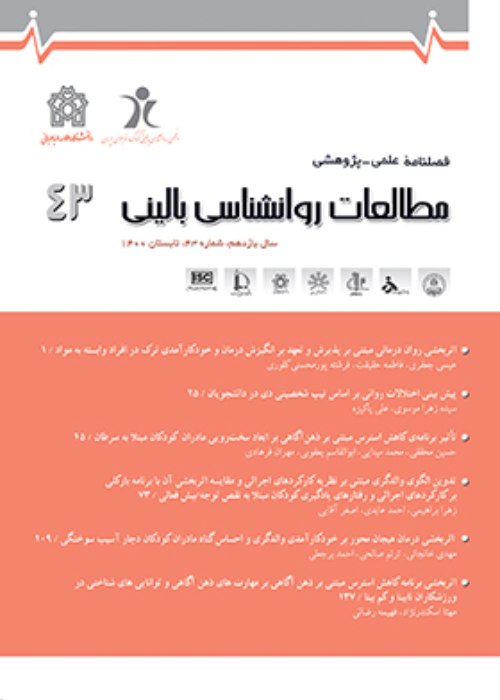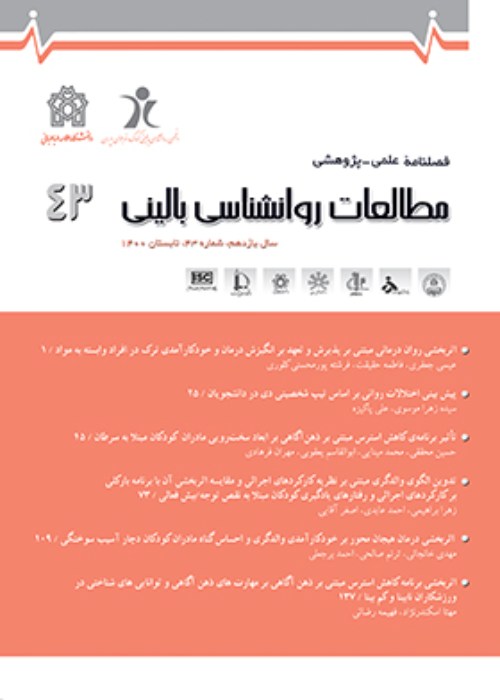فهرست مطالب

فصلنامه مطالعات روانشناسی بالینی
پیاپی 49 (Winter 2023)
- تاریخ انتشار: 1402/06/29
- تعداد عناوین: 6
-
-
Pages 1-15Introduction and Objectives
Covid-19 pandemic in 2020 and the use of quarantine to prevent it have increased psychological reactions like depression, anxiety and stress in the general population. Hence, the need to identify variables that can affect these psychological reactions is felt more than ever. The aim of this study was to predict the rate of depression, stress and anxiety during quarantine based on psychological flexibility, dysfunctional attitude and coping styles.
MethodThe research design was descriptive-correlational and the statistical population included all students who were active in the social media. A total of 501 students accessed the call for completion of questionnaires on online media, including Instagram, completed prepared questionnaires in the Google Form format.
Measures included the Depression, Anxiety, and Stress Questionnaire (DASS-21, 1995), the Revised Dysfunctional Attitude Scale (DAS-26, 1978), the Acceptance and Practice Questionnaire (AAQ-II, 2005), and the Lazarus and Folkman Coping Strategies Questionnaire (CSQ, 1984).ResultsPsychological inflexibility, dysfunctional attitudes, and maladaptive coping strategies predicted depression, anxiety, and stress in a positive way, but problem-oriented coping strategies only showed an inverse relationship with depression. In regression analyzes, the variable of psychological inflexibility had the greatest effect on explaining depression, anxiety and stress.
Discussion and ConclusionIt can be concluded that teaching psychological flexibility and cognitive reconstruction can be useful in reducing depression, anxiety and stress during the quarantine. Teaching problem-solving strategies can also have positive effects on reducing depression.
Keywords: Cognitive Dysfunction, Coping Skills, Corona Virus, Pandemics, Psychological Flexibility, Psychological Stress, Social DistanceKeywords: Cognitive Dysfunction, Coping Skills, Corona virus, pandemics, Psychological Flexibility, Psychological Stress, Social Distance -
Pages 17-36
Purpose Premenstrual syndrome (PMS) is usually observed among women of reproductive age, so, it may be worsened by emotional and somatic symptoms. The main aim of this investigation was to assess the predictability of pain intensity and psychological distress by personality traits and self-regulation skills among the Iranian female population.Methods The data were collected via numeric pain assessment, DASS-42, NEO, SRQ, and demographic questionnaire. The significant level was set at 0.05. In this study, we used the method of variance-based structural equations by PLS software.Results Pearson correlation between total score of self-regulation skills and subscales of DASS-42 stress, anxiety, and depression were respectively (0.78), (0.71), and (0.73). Thenceforward, the correlation between pain intensity and total score of self-regulation skills was (0.72). Moreover, results showed that the correlation between personality traits scores with subscales of DASS-42 stress, anxiety, and depression were respectively (0.71), (0.73), and (0.87). Finally, data analysis demonstrated a correlation between self-regulation skills and pain intensity (0.70). (P= 0.05)Conclusions This article shows that personality traits and self-regulation skills can significantly predict the degree of pain intensity and psychological distress among females before and during menstruation concerning mediating role of suggestibility and attitudes toward menstruation.
Keywords: Menstruation, Distress, pain, Pre-menstruation, Personality traits -
Pages 37-53
Using religious/spirituality (R/S) in psychotherapy changes the way clients look at their problems. Activation of Spiritual Dimension (ASD) based on attention on the two ultimate domains of perception filed, including "origin" and "resurrection" (hereafter) of existence, along with perceived "self" and "objective world" dimensions, as well as spiritual self-regulation, is the core of God-Oriented Spiritual Psychotherapy (God-OSP). The purpose of this article is to introduce the God-OSP protocol, its theoretical principles, content validity, and its clinical effect on psychological problems, especially anxiety, and stress. Both qualitative methods (such as content analysis and clinical phenomenology) and quantitative methods such as content validity index calculation have been used to analyze the data. The validation of the protocol was conducted with the rating of 10 expert psychologists that were familiar with both psychotherapy and religion content and self-reported rating scales and with 35 clinical psychologists and consultants that interest in participating in God-OSP. Results indicate that God-OSP with 5 stages, shows validation in expert psychologist rating and is also valid and reliable in self-report participant clinical psychologists. Spiritual action management, activation of innate intellect and God-oriented Wisdom, awareness of spiritual Identity, and real conceptualization of the core concepts of perceptual domains, are very important components of the protocol to ASD. The findings also showed that it is possible to design and implement the principles, mechanisms, and techniques of therapy for ASD based on Islamic religious sources. Therefore, it is possible to design effective interventions for emotional problems based on religious sources.
Keywords: Spiritually Multidimensional psychotherapy, religious psychology, God Image, God-oriented spiritual psychotherapy (God-OSP), spiritual psychotherapy -
Pages 56-69
This study was conducted to determine the effect of group logo-therapy on self-esteem, social skills, and anxiety among adolescent girls in Tehran, Iran. The research was performed in a semi-experimental method with two groups (15 girls per group): one experimental group with logo-therapy and one control group with treatment as usual. The Coopersmith Self-Esteem Inventory, the Teenage Inventory of Social Skills, and Beck Anxiety Inventory have been applied to both groups in the pre- and post- intervention phases. Data were analyzed using Analysis of Covariance. Our results showed that group logo-therapy affected the levels of self-esteem and anxiety, but not social skills of these young girls. This study suggests that group logo-therapy may be useful for boosting some aspect of positive functioning of adolescent girls like self-esteem or reducing their negative feelings in response to anxiety but it may not be useful in improving their social skills. Implications of results have been discussed.
Keywords: Logo-therapy, Self-esteem, social skills, Anxiety, adolescence -
Pages 71-85
The present study aimed to predict the tendency toward cosmetic treatments based on early maladaptive schemas and marital intimacy among married men applying for cosmetic surgery and non-applicant in the province of Yazd in 2020. The descriptive-correlation method is used. The statistical population of this study was all married men who applied for cosmetic surgery referred to relevant clinics and non-applicant married men in Yazd. According to this, a sample of 200 people, including 100 applicants and 100 non- applicant who were selected by available sampling. Then, Early maladaptive Schemas scale (Yang, 1998) and Bagarozzi's marital intimacy questionnaire (2001) were distributed among the subjects and after completing the questionnaires, the results were analyzed through logistic and Pearson correlation calculation.There is a significant relationship between different domains of early maladaptive schemas and intimacy of couples; Also, The findings showed that early maladaptive schemas and marital intimacy predict the tendency for cosmetic surgery in married men. The results of multiple regression analysis showed that the three maladaptive schemas of autonomy and dysfunctional functioning, acceptance, cut and rejection, as well as the interference component in social performance of body image, respectively, had the highest share in predicting the tendency for cosmetic surgery, respectively. The schemas in a person's life act as lenses that shape the interpretation, selection, and evaluation of one's experiences. Considering the role of early maladaptive schemas and marital intimacy in predicting the tendency to cosmetic surgery in this study, it is suggested to provide psychological treatments, especially schema therapy and couple therapy, before cosmetic surgery.
Keywords: Tendency to Cosmetic surgery, early maladaptive schemas, Marital Intimacy, married men -
Pages 88-114Methods
This research was administered in three stages. First, a psycho-cognitive remediation treatment manual was developed based on the most reliable existing treatments: Cognitive Behavior Therapy (CBT) and Cognitive Remediation Therapy (CRT). In the second stage, the content validity of the manual was evaluated by 8 experts. Finally, the effectiveness of the developed treatment was evaluated by the quasi-experimental method with an active control group, pretest-posttest follow-up design. 28 adults aged 24-45 years who had been diagnosed with MDD were purposefully selected and assigned to one of the two experimental or control groups. The experimental group participated in 12 two-hour weekly sessions and the control group played video games at home. The Beck Depression Inventory-Second Edition (BDI-II) and the THINC-it tools as neuropsychological tests were used for gathering data. Only 25 patients remained in the study at week 12. To statistically analyze the data, One-way analysis of covariance was used (SPSS 26).
ResultsData analysis showed that depression and anhedonia were significantly lower at the post-test compared to the pre-test, according to the BDI-II and SHAPS scores. All objective and subjective cognitive functions were significantly improved. Follow-up scores remained significantly constant in the tests that had improved in the post-test which indicates the stability of therapeutic effects in the three-month follow-up.
ConclusionThis is the first study to evaluate two validated combined therapies in adults with MDD, as far as the authors are aware. It was evaluated based on feasibility, acceptability, and effectiveness. It is suggested that clinicians use these combined treatments in the field of clinical practice. Although this treatment manual had a good effect, some of its limitations must be addressed in future research.
Keywords: major depressive disorder, Cognitive behavior therapy, Cognitive Remediation, Cognitive Dysfunction


